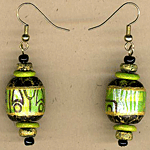|
Welcome to the eighth issue of the Carolyn Hasenfratz Design and Carolyn's Stamp Store email newsletter. When times get tough, there never seems to be enough of anything to go around. This issue of my newsletter is dedicated to exploring different ways of conserving the valuable assets of natural resources, money and time.

Contents:
The Green Issue
People who know me very well might be a little surprised to see me putting out a "green" issue of my newsletter - I'm not of the political persuasion one normally associates with being "green", and I think climate change is a natural phenomenon with cycles that have repeated themselves throughout the Earth's history and that for humans to pursue practices that are detrimental to our fiscal well-being and political autonomy in order to try change it is folly in my opinion. On the other hand, if an idea promoted in the name of Global Warming otherwise makes sense I don't think those are necessarily reasons to reject it.
To cite a relatively frivolous example, in Facebook there is an application called (Lil) Green Patch. A simplified description if you're not familiar with it is that friends send you plants for your patch and you send them plants back, and you can earn money to buy more plants by tending your friends' patches. I like real gardening so I was intrigued, but the Global Warming part put me off at first. Eventually I investigated it to see exactly how this application is supposed to affect the environment. I learned that as you use the application, sponsors donate money to the Nature Conservancy's Adopt an Acre program. According to them, this money is used to acquire land, plant trees and restore native vegetation, hire and train park guards and staff to protect against illegal logging and poaching, and work with private landowners to establish permanent conservation easements. These activities would seem to have actual benefits to the environment that I think have merit, so I eventually decided to participate.
There are lots of other environmentally-friendly things I do that are unrelated to politics or ideology or beliefs about Global Warming. I'm enthusiastic about recycling because it helps save resources that are finite, like some forms of energy used to convert raw materials to products used in manufacturing, and gets rid of a lot of unsightly trash. The proportion of recyclables vs. trash that leaves my house is probably about 10 to 1. I have a pesticide-free garden around my condo where there was once only a barren, lifeless, strip of mulch. Maintaining my own little green oasis in that space is something that Global Warming activists would approve of because plants absorb CO2 - they need it to live. In addition to that my little garden helps prevent soil erosion, provides habitat and food for wildlife, improves local soil and water quality, and since I grow a lot of things from seed and save seeds from year to year, it helps to preserve the genetic diversity of valuable plants, all things I think are important. I've been keeping aquariums and vivariums for many years starting at the age of eight, which has made me acutely aware of water quality and how it affects aquatic systems and organisms, so I am careful of how I dispose of toxic substances, and try to use less of them in things like household cleaning, fragrance, and personal care products by making some of my own from more benign materials. I walk to a lot of my errands. Reducing emissions from cars is one reason some people do this, but other great benefits that I care about are excercise and saving gas money. I try to find ways to re-use things instead of throwing them away. Whenever I can, I try to get things repaired instead of buying new things. I donate still usable items that I don't want and give broken electronics to someone that will recycle the components.
A lot of people reading this newsletter now are involved in crafts, and if you are you're probably aware that crafts provide excellent opportunities to get more life out of things that are no longer useful for their original purpose. Yes, well-known craft divas get made fun of for teaching people how to make things out of lint or whatever, but repurposing scrap items makes a lot of sense when you think about it - you are reducing waste while making something nice for a lower cost, and enjoying a healthy, creative hobby activity while doing it. Check out these examples:
A local organization that makes such craft activity their mission is Leftovers, Etc. I like to go there to not only donate items I don't need but pick up reusable items at a low cost. For my office, I've acquired three ring binders, hanging file folders, CD cases, and floppy disc storage units. For my crafting activities, I've obtained artificial flowers, fabric, ribbon, molds, ceramic tiles, and embroidery thread. Leftovers, Etc. is in need of funds and volunteers, so if you have either time or money to give, that is one place where you can make a tangible difference.
Rubber stamps are craft tools that are extremely useful for giving a new look to recycled materials. There are stamp designs for every taste and rubber stamping inks available for just about any surface that you would like to decorate, including glass, metal, fabric, and plastic. Here are some examples:
As a business person, I don't think it's fair to put all the burden for being environmentally friendly on the consumer, so I have given some thought to making some aspects of my rubber stamp business green. The stamps themselves are made of rubber and wood, which are renewable plant-based products that will biodegrade over time. The manufacturer of my stamps, Stamp N Plus Scrap N, makes some of the wood mounts out of recycled wood. Although not every product in my catalog is made in the USA, which has stricter environmental regulations than some other countries that do manufacturing, most of the products such as the stamps themselves, the majority of the stamping inks, acrylic mounting blocks, (etc.) are.
There are some things I could do better, for example when my current supply of padded envelopes runs out I'm considering switching to envelopes that are recyclable.
A couple of the "greener" items that I've recently added to my catalog are:
- Plantable Seed Paper - Handmade paper embedded with wildflower seeds. When the paper is planted in a pot of soil, wildflowers will grow from the paper. Acid-free, deckled edges. Made in Canada from recycled bond paper, cotton remnants and abaca, a renewable leaf fiber.
- Recycled Wooden Car Seat Beads - Someone gave me an old beaded car seat years ago, and while I've used many of the beads in craft projects over the years (here is an example, and another), I still have a lot left. They work well with rubber stamping and decoupage, so I have made some available in my catalog. Scroll farther down to get ideas for how to make a couple of car seat beads into earrings.
 To further encourage the use of found or repurposed materials, I've added an envelope of goodies to my incentive for participating in the Gallery at Carolyn's Stamp Store. Here is how it works. If you own any rubber stamps from my collection, send me a scanned image or photo of something that you made with one or more of my stamp designs. It may include images from other rubber stamp companies - if it does please include credits. If you have a web site or blog, you may have a link back from your gallery listing. In return, you'll get a collectible mounted rubber stamp of my logo, and while supplies last an envelope of goodies you can use in your paper craft or other projects. See the Gallery for more details.
To further encourage the use of found or repurposed materials, I've added an envelope of goodies to my incentive for participating in the Gallery at Carolyn's Stamp Store. Here is how it works. If you own any rubber stamps from my collection, send me a scanned image or photo of something that you made with one or more of my stamp designs. It may include images from other rubber stamp companies - if it does please include credits. If you have a web site or blog, you may have a link back from your gallery listing. In return, you'll get a collectible mounted rubber stamp of my logo, and while supplies last an envelope of goodies you can use in your paper craft or other projects. See the Gallery for more details.
Content is Valuable: Repurpose It With Technology
I have begin a five-part blog post series on the Webinar Resources Blog on how to get the most out of the content you create by using different online services and applications to leverage the content as much as possible, for example text messages, PowerPoint presentations, photos, and blog posts. I don't know how many of the posts will be up by the time this newsletter is sent out, so I'll just link to the first installment:
If you like it, sign up for our blog feed by clicking the RSS icon  and you'll get our future blog posts delivered to feed aggregator of your choice, or share it with the Share This icon and you'll get our future blog posts delivered to feed aggregator of your choice, or share it with the Share This icon  . Your comments are welcome. . Your comments are welcome.
What if you could choose to pay less?
Imagine going into an office supply store and seeing two items you need for your business that appear to be identical in every way. The item number is the same, the UPC code is the same, both boxes are factory-sealed. The only apparent difference is that one has the price of $25.00 marked on it, and the other has the price $100.00 marked on it. Your first impulse is to choose the $25 dollar item, but you are suspicious. You assume there must be a reason for the huge price difference, that there must be something wrong with the less expensive item. You find a store clerk and ask what the difference between the two items is. "There is no difference," explains the clerk, "except for the price. It's entirely your choice which price you want to pay."
If you believe the clerk, you would grab the item marked $25.00. It doesn't make sense to voluntarily pay $100.00 for something that you can get for $25.00. Yet business customers, who know they have to watch their costs because they have competitors, often choose to pay more than they have to when they buy services from other companies.
Do you buy services that involve you providing some kind of information to the provider such as copy, images, or page layouts? For example, having documents designed or printed, having web applications built, and things of that nature. Are you paying too much when you don't have to? No, I'm not suggesting you look for a cheaper provider. I'm suggesting that you ask yourself the following questions about your company's practices when you deal with service providers.
- Do we plan out the entire project ahead of time, or do we tell the service provider to start it when we don't yet know what the total picture is?
- Do we let the service provider know all of our requirements before they start work, or do we spring new requirements on them when the project is already under way?
- Do we give the service provider all the materials they need to do the job at one time, or do we let them have it only in dribs and drabs?
- Do we hand over our materials to the service provider only after all parties who need to approve it have already done so, or do we wait until the service provider has already done their work formatting the content to get final approval on what the content is?
- Do we spell check and proofread our text before we hand it off, or do we expect the service provider to find and fix any errors?
- Do we simply change our mind about the content multiple times after the service provider has begun work?
- Do we have one point of contact who relays all instructions to the provider, or do we have multiple people contacting the provider with conflicting instructions?
Do any of those scenarios sound familiar? If so your organization might be paying anywhere from twice as much to four times as much as you need to for services. By my personal observations, I estimate that is the usual range of increase in the time, and therefore money, it takes to do a project if the above inefficient behaviors come into play. That is the same as walking into the office supply store and voluntarily paying $50.00, $75.00, or even $100.00 for an item that you could have purchased for $25.00. You wouldn't want to go to your boss and explain why you decided to do something like that, would you? But with services, paying more than you need to is not a rare occurrence. If you pay for services by the hour, you are probably thinking to yourself, "So tell me what I don't know already!"
If you pay by a price quote, you might be thinking, "But I don't pay for services by the hour, so why do I need to worry about being organized?" I can think of three good reasons why without even trying very hard. And they're not things that benefit your service provider (you thought I was going to get into that didn't you, since I am one) - they are things that benefit YOU - the client.
First of all, if your service provider is giving you a price quote for the total job, they are very likely building extra money in your quote to compensate for the extra time that is needed to work in an inefficient way, since the inefficient way is very common and they don't want to get burned by a project that gets out of control. If they have worked with you before and know that you are likely to make an unusual amount of changes in midstream, they are possibly charging you more than they would charge other clients who don't do that. (Conversely, if they know from past experience you are very organized they are likely to quote you less.) Getting a higher price quote is bad news for you, but money isn't the only issue.
Secondly, human error is a factor. The more times a person has to work on a file, the more chances there are to make a mistake, such as, what the file is named, what version is the correct one, what directory does it go in, uploading old content by mistake, simple typos, accidental deletion, etc. The fewer times human hands have to touch the files, the safer from embarrassing and costly errors you are.
And thirdly, isn't YOUR time important? How would you rather spend it? Looking for new business and giving better service to your existing customers, or calling your service provider multiple times and sending multiple emails, having conversations about changes in the project that could have been avoided completely it if the project had been thoroughly planned and explained before work began?
The choice is yours - will you pay less for services and enjoy the other competitive benefits you get from taking the time to plan your project?
Online Forms: Green, with Benefits
Here is a link to a recent
blog post which explains why adding online forms to your web site might not only be good for the environment but your productivity as well.
 Featured Craft Project from Carolyn's Stamp Store: Recycled Car Seat Bead Earrings
Featured Craft Project from Carolyn's Stamp Store: Recycled Car Seat Bead Earrings
By dressing up a couple of wooden beads from a recycled car seat cover, you can make earrrings that are not only pretty, but inexpensive and lightweight.
Click here for Recycled Car Seat Bead Earrings.
Until next time,
Carolyn Hasenfratz
Links to former newsletter issues:
If you would like to add yourself to the list to receive future issues of this newsletter, please fill out the short form below. Thank you!
|



